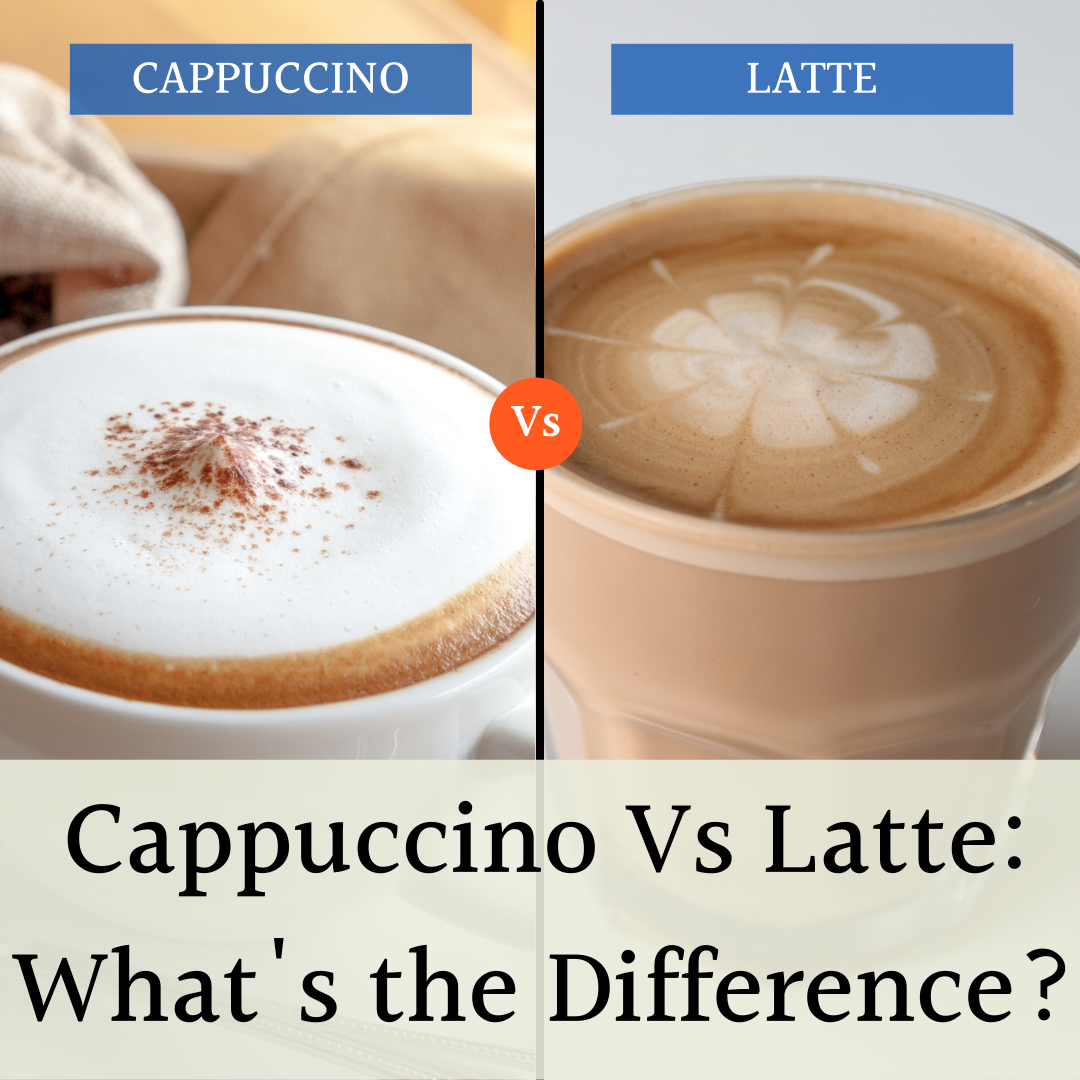
According to a 2023 report by the National Coffee Association, espresso and latte are among the most popular coffee drinks in the US. But what’s the difference between a cappuccino vs. latte?
The main difference is cappuccino has more milk foam and a stronger espresso taste. A latte has more steamed milk, which gives a creamy texture with a thin layer of milk foam. Both drinks use a double shot of espresso, steamed milk, and milk foam.
Coffee shops prepare each drink differently, making it hard to compare a cappuccino vs. a latte. I decided to do a taste test using a cappuccino and latte from Printer’s Row Coffee. The side-by-side comparison from a craft coffee shop made the differences clear.
Let’s start with each drink then get into the taste test. Feel free to jump ahead:
What Is A Cappuccino?
A cappuccino starts with a shot of espresso, followed by a layer of steamed milk, topped with a thick and airy layer of milk foam. The common recipe for cappuccino is ⅓ espresso, ⅓ steamed milk, and ⅓ milk foam.
The Certified Italian Cappuccino uses a little more steamed milk with 25ml of espresso and 100ml of steamed milk. The Specialty Coffee Association of America broadly defines a cappuccino:
“A cappuccino…should produce a harmonious balance of rich, sweet milk, and espresso. A cappuccino is prepared with a single shot of espresso, textured milk, and a minimum of 1 centimeter of foam depth.”
-Specialty Coffee Association of America
All cappuccinos have three distinct layers in common: espresso, steamed milk, and milk foam. The foamed milk layer is an important touch for a cappuccino. The foam is airy, yet the milk bubbles should be dense to the point where the foam sticks to a spoon. A good cappuccino milk foam will leave a milk mustache after a big first sip. The steamed milk layer shouldn’t overpower the espresso. The espresso taste should come through within a few sips.
Making a cappuccino is a test of barista skills. The milk needs to be steamed longer to create an aerated texture. The steam wand should be closer to the surface of the milk jug to create dense milk foam. The barista needs to feel the 1:1 ratio of steamed milk to espresso before placing a milk foam layer on top.
Pro tip: The “spoon test” is a way to check the construction of a cappuccino. Lay a teaspoon flat on top of the cappuccino. If the spoon rests on top of the cappuccino, the milk foam is the right thickness and density.
A cappuccino is a small drink with six ounces of volume, less than a cup of coffee. The drink is meant to be finished quickly – local Italians will finish their cappuccino within a few sips to start the day!
The origin of the name cappuccino is under some debate. The most common story is the word cappuccino comes from the Capuchin monks in Italy whose hooded robes, the cappuchio, matched the brown color of espresso mixed with milk foam. The problem with this narrative is the Capuchin monks pre-date espresso by a few hundred years. The other origin story is cappuccino comes from the Vienna coffee drink kapuziner, where milk foam was added to coffee.
Either way, the cappuccino stands for a foamy coffee drink with a light brown color.
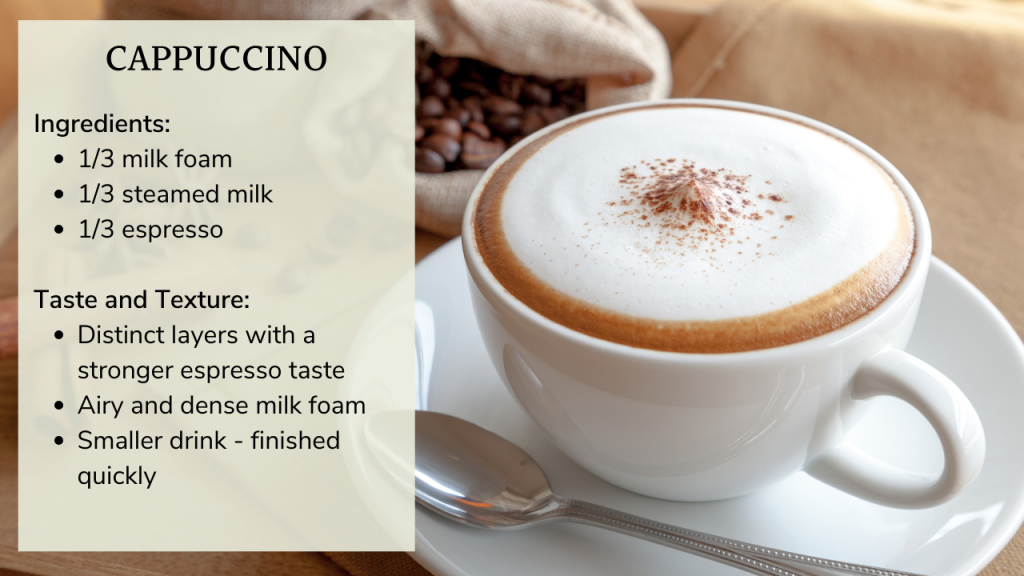
What Is A Latte?
The word latte translates to “milk” in Italian. If you ask for a “latte” in Italy, expect a cup of milk! Ask for a caffe latte in Italy to get the typical latte drink from a Starbucks.
The latte starts with a double shot of espresso, like a cappuccino. Lattes have a much thicker layer of steamed milk and a thin layer of milk foam on top.
Where a cappuccino is an even ratio of three ingredients, a typical latte will have an espresso to milk ratio between 1-to-5 and 1-to-4 depending on the size of the drink. Bigger drinks have a higher proportion of milk. A typical ratio is ~20% espresso, ~70% steamed milk, and ~10% milk foam. The milk foam layer is only finger width.
A latte is all about steamed milk. The steamed milk is stretched with a small amount of aeration, so the milk blends with the espresso. The steam wand should be closer to the bottom of the milk jug to evenly stretch the milk.
The steamed milk layer gives the latte a subtle espresso taste and creamy texture. The three layers are barely noticeable in a latte.
Lattes are usually served as large drinks. Most lattes are 12-ounce drinks with two ounces of espresso, eight ounces of steamed milk, and two ounces (or less) of milk foam. Lattes are casual coffee drinks enjoyed during the morning.
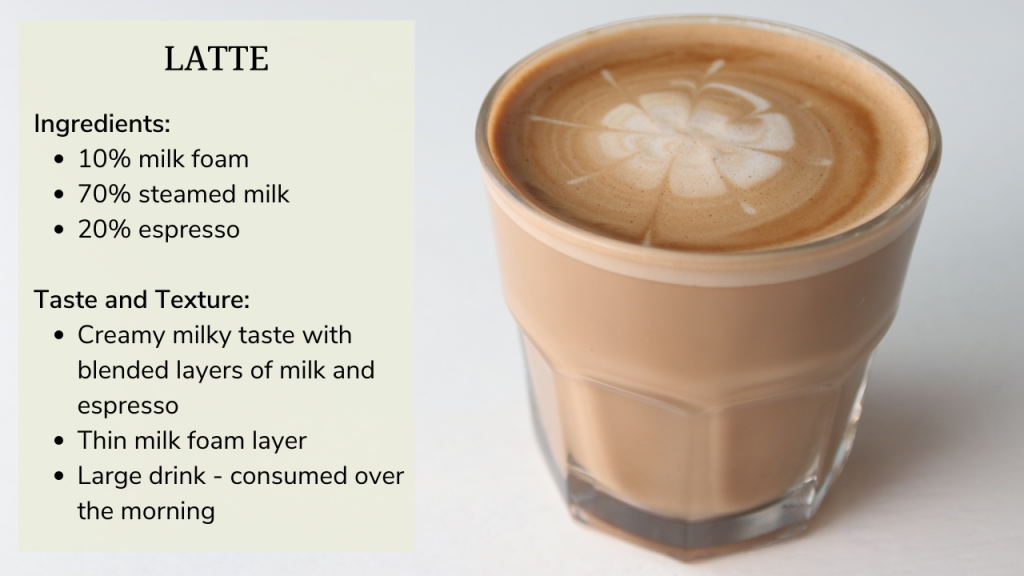
Cappuccino Vs. Latte: The Taste Test
Are the differences between a latte and a cappuccino really noticeable? I put it to a taste test using a latte and cappuccino from Printer’s Row Coffee. I enlisted a coffee taster (my roommate) as a second check. Here’s how the latte vs. cappuccino compared.
Appearance
Each drink was eight ounces and ordered to-go. Both drinks look the same at first glance. The cappuccino was lighter than the latte by weight, a sure sign of the extra foam.
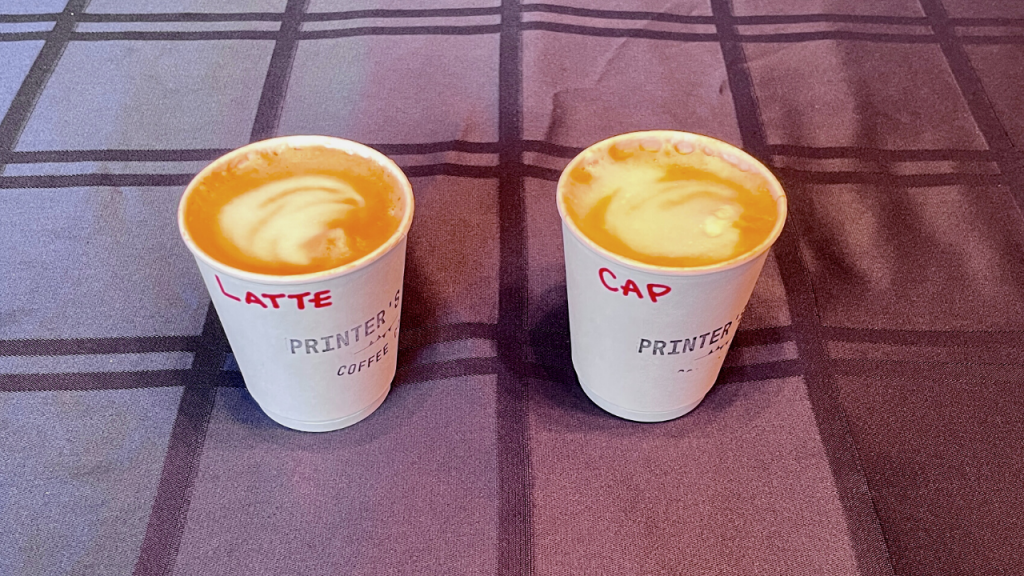
Foam: the “Spoon Test”
Did the cappuccino have a thick, dense, and airy layer of foam on top? We conducted a spoon test, laying a teaspoon across both cappuccino and latte. The spoon comfortably floated on the cappuccino, supported by a thick foam layer. Meanwhile, the spoon (barely!) sank for the latte.
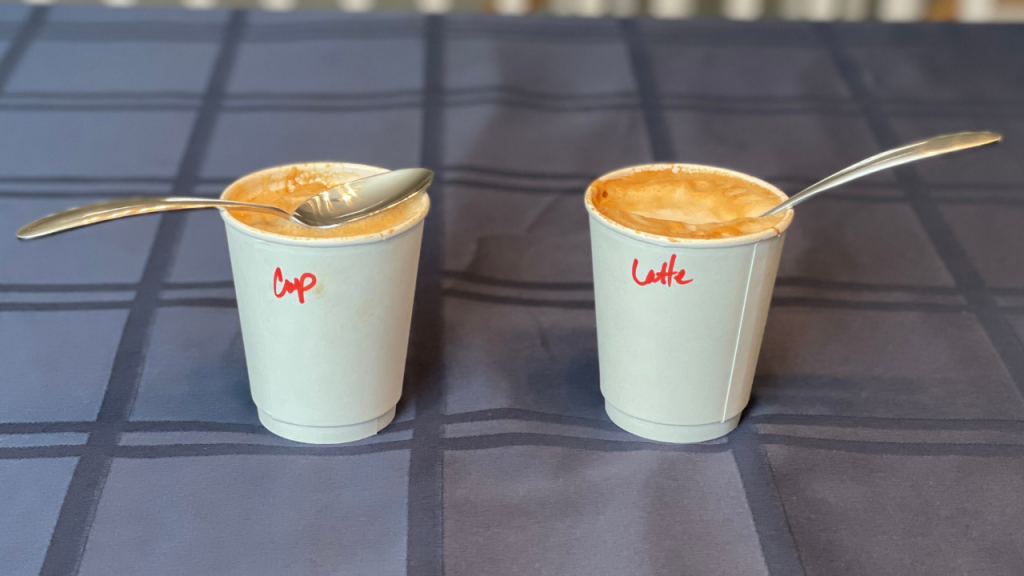
I could carve the milk foam off the cappuccino. The foam was dense and clung to the bottom of the spoon. The latte had a thinner layer of foam with the same foam texture.

Well done, Printer’s Row.
Taste and Texture
The cappuccino enters the mouth in distinct layers. The first sip was foam, while the second sip was steamed milk with a clear espresso taste. Each sip had multiple textures, including a light foam layer, a rich milk layer, and a dark espresso taste on the base.
The latte tasted like one blended layer. The foam was barely apparent while the steamed milk was apparent in every sip. The texture was creamy with a subtle espresso taste throughout the drink. The latte took an extra few sips to finish.
How Many Caffeine and Calories in Cappuccino vs. Late?
The latte and cappuccino have the same caffeine since they both have a double shot of espresso.
A typical 12-ounce latte has 210 calories compared to 130 calories for a cappuccino since the latte has more streamed milk. I asked for whole milk for both drinks and could have evened out the calories with skim milk (Printer’s Row Coffee had five milk choices).
Final Verdict
I preferred the cappuccino. The espresso taste came through stronger with a nice foam layer. I could finish the cappuccino faster, which is better for me since I’m usually rushing in the mornings.
My roommate preferred the latte. She liked the balanced flavor, creamy texture, and subtle taste of espresso. She drinks coffee slowly, enjoying each sip before starting the day.
In the end, the morning routine determined our preference more than anything else! It’s all personal preference for choosing a cappuccino vs latte.
Now that you know all about cappuccino vs. latte, check out our guide on espresso, and all of our machine reviews to start brewing your own milky espresso drinks at home.

